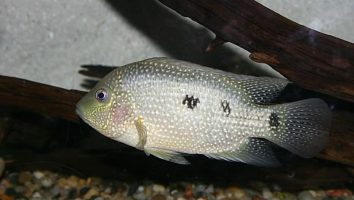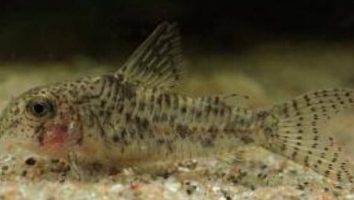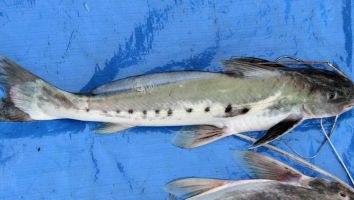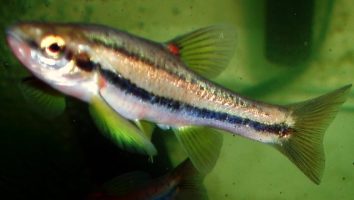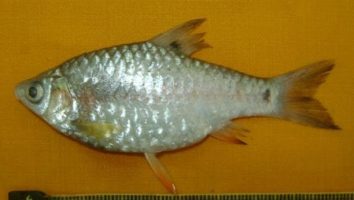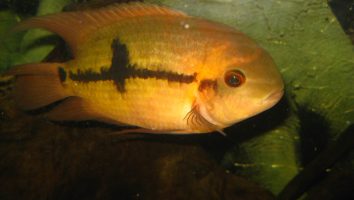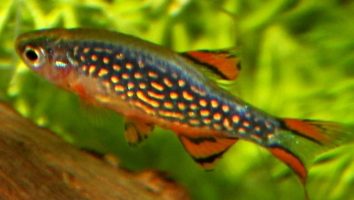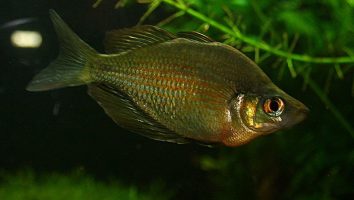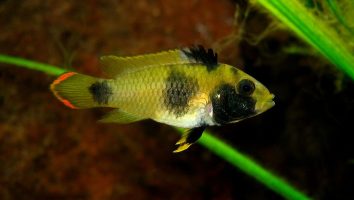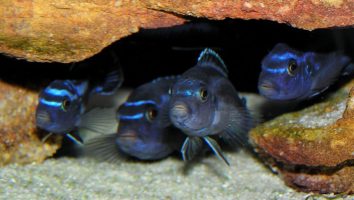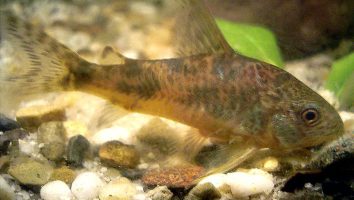The snakeskin gourami is a beautiful freshwater fish that is perfect for the beginning aquarist. They are easy to care for and don’t require a lot of maintenance.
This species is also a great addition to any community tank. They are peaceful and get along well with other fish.
If you’re thinking about getting a snakeskin gourami, this guide will teach you everything you need to know about their care.
Table of contents
Species overview
The snakeskin gourami (Trichogaster pectoralis) is a species of gourami that is native to Thailand, Cambodia, and Vietnam.
They are found in slow-moving waters that are heavily vegetated. This is something that is common to many gourami species, as they tend to prefer these types of environments.
The snakeskin gourami gets its name from the unique pattern on its body which resembles the skin of a snake. This pattern is quite striking and is one of the main reasons why this fish is so popular among aquarium enthusiasts.
These fish are generally peaceful, although they can be a bit aggressive toward their own species. This is something to keep in mind if you are planning on keeping more than one snakeskin gourami in the same tank.
Appearance

The first thing you’ll notice about the Snakeskin gourami is their namesake feature: their scales. These fish have very large and thick scales that give them a bit of a “snakeskin” appearance (especially on their sides).
The coloration on these fish is very dark overall. The base color is black with a few brown or tan spots. The spots are usually in a line that runs from the gills to the tail.
The fins on the Snakeskin gourami are very long and streamline. The dorsal fin runs almost the entire length of their body and is tall and thin.
The anal fin is a bit shorter but still extends a good portion of the way back. The caudal fin is forked and symmetrical.
The pectoral fins are large and paddle-like. They help the fish steer and maneuver in the water column.
The ventral fins are small and thin. They’re located right under the gills and help with stability.
Lifespan
The average lifespan of a snakeskin gourami is 5 to 7 years. However, like all fish, there are a number of factors that can impact their lifespan.
For example, if they’re kept in poor water conditions then their lifespan will be drastically reduced. These fish are also very sensitive to stress. So, if they’re constantly being harassed by tank mates or if the water quality is poor then their lifespan will be shortened.
Size
A full-grown Snakeskin gourami can reach a length of 6 inches, with the males usually being larger than the females.
Tank
Tank Size
The minimum tank size for a snakeskin gourami is 20 gallons. If you want to keep more than one snake skin gourami in the same tank, you should add an additional 10 gallons for each fish.
Water Parameters
As with most fish, the snakeskin gourami prefers water that’s clean and well-oxygenated. They come from slow-moving waters in Southeast Asia, so the current in your tank shouldn’t be too strong.
Gouramis are also known to be a bit more sensitive to water quality than some other fish. For that reason, you may want to consider using a filter that’s overkill for the size of your tank. This will help you keep the water clean and free of ammonia and nitrites.
Here are some general water guidelines for keeping snakeskin gouramis.
- Water temperature: 72 to 82 degrees Fahrenheit
- pH levels: 6.0 to 7.8
- Water hardness: 2 to 12 dGH
- Alkalinity Levels: 3-8 dKH
What To Put In Their Tank
When it comes to setting up the inside of a Snakeskin Gourami’s tank there are a few key things you need to take into account.
First and foremost among these is the fact that these fish are peaceful by nature. This means that you need to avoid putting anything in their tank that could lead to aggression (like large rocks or driftwood).
Instead, you should focus on creating a habitat that’s rich in vegetation. This will give them plenty of places to hide and feel secure.
We recommend using plants like Java Moss, Hornwort, or Water Wisteria. These are all great choices that will do well in a wide range of water conditions.
The substrate you choose is also important. These fish like to dig and root around, which can damage delicate plant roots. A sand substrate is a good choice since it’s soft and won’t damage the plants.
Common Diseases
These little guys are actually pretty hardy and don’t get sick often. However, there are still a few diseases that you should be on the lookout for.
The most common disease you’ll see in snakeskin gouramis is ich. As always, ich is quite serious and can even be fatal if it’s not treated properly.
The good news is that ich is relatively easy to treat if you catch it early. The white spots that are the hallmark of this disease will appear on your fish’s body, fins, and gills.
If you see this, it’s important to begin treatment immediately. There are a lot of different ways to treat ich, but the most common (and effective) method is to raise the temperature of the water in your tank.
This will speed up the life cycle of the ich parasite, causing it to die off before it can do serious damage to your fish.
Another disease to look out for is fin rot. This is a bacterial infection that will cause the fins of your fish to deteriorate. If you see this, it’s important to treat it immediately as it can quickly spread to the rest of the fish in your tank.
The best way to prevent these diseases is to maintain a clean and stable tank. This will help to keep your fish healthy and resistant to disease.
Behavior & Temperament
The snakeskin gourami is a beautiful and unique fish that is native to Southeast Asia. These fish are peaceful and can be a great addition to a community tank.
The snakeskin gourami is a bottom-dweller and will spend most of its time near the substrate. These fish are known to be good algae eaters and will often help keep your tank clean.
The snakeskin gourami is a peaceful fish, but it can be territorial with other gouramis. If you are keeping more than one gourami in your tank, it is best to keep them well-fed to avoid any aggression.
These fish are also known to be jumpers, so it is important to have a tight-fitting lid on your tank.
Tank Mates
The snakeskin gourami is a beautiful fish that’s perfect for the community tank. These fish are peaceful and get along well with other species.
They’re also easy to care for, which makes them a good choice for beginner aquarists.
When it comes to choosing tank mates, there are a few things to keep in mind.
First, snakeskin gouramis come from slow-moving waters in Southeast Asia. As a result, they prefer tanks with similar water conditions.
That means you’ll want to avoid fish that are too active or require high water flow.
Secondly, these fish are on the small side. They only grow to be about 3 inches long. As a result, you’ll want to avoid tank mates that are too large or aggressive.
Some good choices for snakeskin gourami tank mates include:
- Neon Tetras
- Ghost Shrimp
- Guppies
- Platies
- Mollies
- Swordtails
- Corydoras Catfish
Breeding
The snakeskin gourami is a beautiful but difficult fish to breed. They’re not the easiest to sex and their fry are very delicate. However, if you’re up for the challenge, breeding these fish can be very rewarding.
As with most fish, the first step is to sex your snakeskin gouramis. Females are usually larger and have a rounder body shape. Males, on the other hand, are smaller and have a more elongated body.
The next step is to set up a breeding tank. It should be at least 30 gallons and filled with soft, acidic water. The water temperature should be between 78 and 82 degrees Fahrenheit.
You’ll also need to add some plants and other hiding places. This species likes to lay their eggs on plants, so make sure you have plenty. Java moss is a good option.
Once the tank is set up, add two females for every male. Then, feed the fish plenty of live foods.
When the females are ready to spawn, they’ll lay their eggs on the plants. The males will then fertilize them.
After the eggs have been fertilized, the parents will eat them. So, it’s important to remove the adults as soon as the eggs have been laid.
The eggs will hatch in about three days. Once they hatch, you can start feeding the fry baby brine shrimp.
Conclusion
The Snakeskin Gourami is a beautiful fish that is relatively easy to care for. They are peaceful and make a great addition to a community tank.
The biggest thing to be aware of is their potential size. They can get quite large, so make sure you have a tank that can accommodate them.
Other than that, they are easy to care for and make a great addition to any tank!

